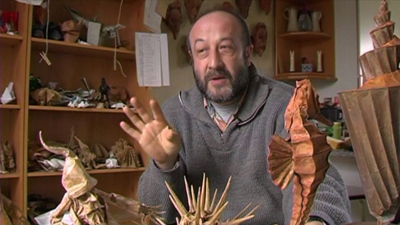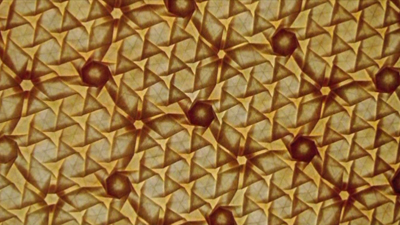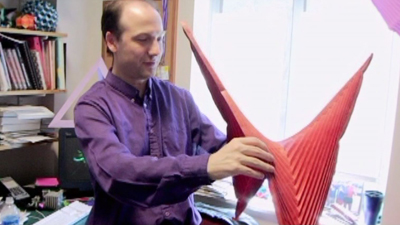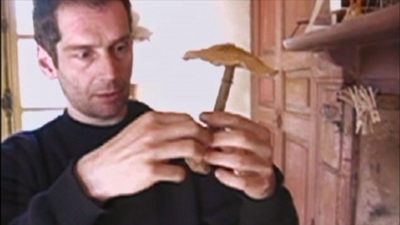Design
Between the Folds
This may be the first documentary I’ve ever seen that I thought was too short. It’s about obsessive paper hackers who fold extreme origami. They make paper do things you would never believe. Sheets are folded into impossible shapes, in impossible ways. Some origami unfolds in almost lifelike gestures. The folders use computers, math, craft, art, and sheer will power to turn uncut paper into anything, even all things. I could watch them do this for hours. It’s magic. It’s deep. It will change your mind about paper. They know things ordinary mortals do not. This documentary will bewitch you, making you ask for more.
–KK




Between the Folds
Vanessa Gould
2008, 55 min.
$16, DVD
Read more about the film at Wikipedia
Rent from Netflix
Available from Amazon
How Buildings Learn
What happens after buildings are built? Why do some buildings get better over time and others get demolished? Stewart Brand says architecture is a prediction, and all predictions are wrong, so the more monumental the architecture, the more wrong the building is. The buildings that thrive are those that can adapt to how people actually use them. The worst buildings for inhabitants are usually statement architecture — buildings that look like art. The best buildings are often nondescript, and pick up character as they evolve. In other words they grow into art.
Brand’s classic book How Buildings Learn and this BBC video series provide example after example of how great spaces are ones that are adaptable. The BBC series is divided into six sections which feature six strategies for designing or redesigning buildings that serve people over time. They travel throughout Britain and the US seeking examples of buildings that learn and ones that don’t. This true film will give you confidence and perspective in altering your own current space, and will transform your mind if you have the opportunity to design a new building, small or large.
— KK
How Buildings Learn
Stewart Brand, James Runcie
1997, 180 min.
6-part BBC series
Six parts available for free on Youtube
Part 1 — Flow
Part 2 — The Low Road
Part 3 — Built for Change
Part 4 — Unreal Estate
Part 5 — The Romance of Maintenance
Part 6 — Shearing Layers
Read more about the film at Wikipedia
http://www.amazon.com/exec/obidos/ASIN/0140139966/ref=nosim/kkorg-20
Helvetica
At their best, documentaries focus on some tiny overlooked corner of life and enlarge it to fill the world. By bridging the micro and macro, a great documentary helps the world make sense. This great documentary focuses on one typographic font, Helvetica. It traces the history of how Helvetica was invented, how it became a default font on most computers, how that popularity catapulted it towards ubiquity in our environment, and what it means that we can find it everywhere, even though we aren’t aware of it. Along the way, we are educated in what fonts do, and how they work. Using interviews with the most renowned typographers living today, this film illuminates the world of fonts — a world we rely on more and more — and the universe of typography and design. Like Helvetica itself, this portrait is trim, radically visible, smooth, and refreshingly modern. It is nearly perfect.
— KK
Helvetica
Gary Hustwit
2007, 80 min.
$3, Amazon Instant Video rental
Read more about the film at Wikipedia
Rent from Netflix
Available from Amazon
Eames Design
Design is hip these days. Long before it was hip, Charles and Ray Eames pioneered the design approach to life. Nowhere is their legacy so well represented as in this single-volume exhibit covering every project in their life’s work. The Eameses were probably the tech-friendliest designers ever, without ever being hi-tech. They certainly were the first on the frontiers of exhibit, museum, and informational film design. They designed types of things that had never been designed before. This book, together with the multi-volume DVD of their brilliant short films, makes it clear that the Eames pursued their passions first. As design goes commercial in a big way, theirs is a mighty inspiring stance. This is the most comprehensive and graphic record of not only their work (3,500 images) but perhaps of any designer’s work. I use this book to expand my notions of what can be designed.
— KK
Eames Design
The Work of the Office of Charles and Ray Eames
John Neuhart, Marilyn Neuhart, and Ray Eames
1989, 456 pages
$74
Available from Amazon
The Films of Charles and Ray Eames
From Amazon, 6-volume box set for $80 or $20 – $25 each:
Vol. 1 “Powers of Ten” and “901: After 45 Years of Working.” 46 minutes
Vol. 2 “Toccata for Toy Trains,” “House: After Five Years of Living,” “Lucia Chase Vignette,” “Kaleidoscope Jazz Choir,” “The Black Ships: and “Atlas.” 62 minutes
Vol. 3 “The World of Franklin and Jefferson,” “The Franklin and Jefferson Proposal Film” and “The Opening of an Exhibition.”
Vol. 4 “Design Q&A,” ” IBM Mathematics Peep Shows,” “SX-70,” “Copernicus,” “Fiberglass Chairs” and “Goods.” 59 minutes
Vol. 5 “Tops,” “IBM at the Fair,” “A Computer Glossary,” “Eames Lounge Chair,” “The Expanding Airport,” “Kepler’s Laws,” “Bread,” “Polyorchis Halpus” and “Tops.”
Rentable from Netflix
Also available from Eames Office
310/396-5991
Excerpt:
Young viewer watching a Mathematica Peep Show. These films were called “peep shows” because they were first shown in devices designed to accommodate one viewer. They were intended for a short attention span; each two-minute film explored one mathematical concept and could be seen as many times as a viewer needed to understand the idea.
The Moebius Band with its traveling red arrow. The arrow is started on its path by pushing a button. 1961.
A large drum made in the Eames Office demonstrated how calendar years and feast days are determined. The drum was divided into horizontal strips, each of which represented one solar year, with the succession of days and full moons marked. The drum charted certain seasonal celebrations–Christian Easter, Orthodox Easter, Passover, Rosh Hashanah, Ramadan, Islamic New Year, winter and summer solstices, vernal and autumnal equinoxes, Thanksgiving and leap-year day–and showed how their dates change from year to year.
















